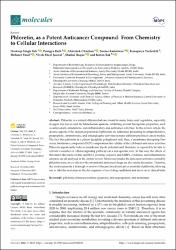| dc.contributor.author | Tuli, Hardeep Singh | |
| dc.contributor.author | Rath, Prangya | |
| dc.contributor.author | Chauhan, Abhishek | |
| dc.contributor.author | Ramniwas, Seema | |
| dc.contributor.author | Vashishth, Kanupriya | |
| dc.contributor.author | Varol, Mehmet | |
| dc.date.accessioned | 2022-12-27T07:56:01Z | |
| dc.date.available | 2022-12-27T07:56:01Z | |
| dc.date.issued | 2022 | en_US |
| dc.identifier.citation | Tuli, H.S.; Rath, P.; Chauhan, A.; Ramniwas, S.; Vashishth, K.; Varol, M.; Jaswal, V.S.; Haque, S.; Sak, K. Phloretin, as a Potent Anticancer Compound: From Chemistry to Cellular Interactions. Molecules 2022, 27, 8819. https://doi.org/10.33/molecules27248819 | en_US |
| dc.identifier.uri | https://doi.org/10.33/molecules27248819 | |
| dc.identifier.uri | https://hdl.handle.net/20.500.12809/10455 | |
| dc.description.abstract | Phloretin is a natural dihydrochalcone found in many fruits and vegetables, especially in apple tree leaves and the Manchurian apricots, exhibiting several therapeutic properties, such as antioxidant, antidiabetic, anti-inflammatory, and antitumor activities. In this review article, the diverse aspects of the anticancer potential of phloretin are addressed, presenting its antiproliferative, proapoptotic, antimetastatic, and antiangiogenic activities in many different preclinical cancer models. The fact that phloretin is a planar lipophilic polyphenol and, thus, a membrane-disrupting Pan-Assay Interference compound (PAIN) compromises the validity of the cell-based anticancer activities. Phloretin significantly reduces membrane dipole potential and, therefore, is expected to be able to activate a number of cellular signaling pathways in a non-specific way. In this way, the effects of this minor flavonoid on Bax and Bcl-2 proteins, caspases and MMPs, cytokines, and inflammatory enzymes are all analyzed in the current review. Moreover, besides the anticancer activities exerted by phloretin alone, its co-effects with conventional anticancer drugs are also under discussion. Therefore, this review presents a thorough overview of the preclinical anticancer potential of phloretin, allowing one to take the next steps in the development of novel drug candidates and move on to clinical trials. | en_US |
| dc.item-language.iso | eng | en_US |
| dc.publisher | MDPI | en_US |
| dc.relation.isversionof | 10.33/molecules27248819 | en_US |
| dc.item-rights | info:eu-repo/semantics/openAccess | en_US |
| dc.subject | Phloretin | en_US |
| dc.subject | Chemoprevention | en_US |
| dc.subject | Apoptosis | en_US |
| dc.subject | Anti-angiogenesis | en_US |
| dc.subject | Anti-metastasis | en_US |
| dc.title | Phloretin, as a Potent Anticancer Compound: From Chemistry to Cellular Interactions | en_US |
| dc.item-type | article | en_US |
| dc.contributor.department | MÜ, Fen Fakültesi, Moleküler Biyoloji ve Genetik Bölümü | en_US |
| dc.contributor.authorID | 0000-0003-2565-453X | en_US |
| dc.contributor.institutionauthor | Varol, Mehmet | |
| dc.identifier.volume | 27 | en_US |
| dc.identifier.issue | 24 | en_US |
| dc.relation.journal | Molecules | en_US |
| dc.relation.publicationcategory | Makale - Uluslararası Hakemli Dergi - Kurum Öğretim Elemanı | en_US |


















